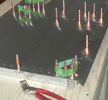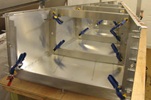


random user submitted photo
Aerovee Turbo Perfomance Question
12 posts
• Page 1 of 2 • 1, 2
Aerovee Turbo Perfomance Question
For those who have a turbo areovee flying how is your map performance at altitude. I know that at sea level the jabiru has superior performance but i am wondering how the turbo holds up at altitude and how cooling vs map delta there is.
Saturday's Building Live Stream
Jill's Build Log
PPL-ASEL
Tail = Complete
Wings = Complete
Waiex-B 0054
Panel G3X
Engine Spyder 120 corvair conversion
Jill's Build Log
PPL-ASEL
Tail = Complete
Wings = Complete
Waiex-B 0054
Panel G3X
Engine Spyder 120 corvair conversion
-

lakespookie - Posts: 260
- Joined: Wed Aug 07, 2019 2:39 pm
- Location: San Diego California
Re: Aerovee Turbo Perfomance Question
For what it's worth, when I was flying the turbo I had no trouble holding climb or takeoff power (35" or 40" MAP) up to 8,000-10,000'. I'm not sure where the critical altitude is on that setup but holding power wasn't a problem. I remember climbing up to 10,000' MSL and if I added power I could easily get to 35" MAP and had more throttle to go. Unfortunately I don't have a transponder so I had to stop there!
I think the size of this turbo is plenty for this engine. Not sure how high you want to cruise but flying at any altitude where oxygen isn't necessary shouldn't be a problem.
I think the size of this turbo is plenty for this engine. Not sure how high you want to cruise but flying at any altitude where oxygen isn't necessary shouldn't be a problem.
Mike Farley
Waiex #0056 - N569KM (sold)
Onex #245
Waiex #0056 - N569KM (sold)
Onex #245
- MichaelFarley56
- Posts: 1485
- Joined: Thu Jun 02, 2011 11:38 pm
- Location: Columbus, Ohio
Re: Aerovee Turbo Perfomance Question
Good question. I have a Turbo Aerovee and have taken it up as high as 8500ft. At those higher altitudes (or really any altitude in general) it's all about cooling. I can bring the MAP up to 35" no problem but in the middle of a southern summer I wasn't comfortable climbing any higher than 8500' due to both CHT and Oil Temp reaching their limits, I was having to pull the power below 30" to keep everything in check... this didn't give me a lot of headroom to keep climbing above 8500'.
Ryan Roth
N197RR - Waiex #197 (Turbo Aerovee Taildragger)
Knoxville, TN (Hangar at KRKW)
My project blog: http://www.rynoth.com/wordpress/waiex/
Time-lapse video of my build: https://www.youtube.com/watch?v=Q8QTd2HoyAM
N197RR - Waiex #197 (Turbo Aerovee Taildragger)
Knoxville, TN (Hangar at KRKW)
My project blog: http://www.rynoth.com/wordpress/waiex/
Time-lapse video of my build: https://www.youtube.com/watch?v=Q8QTd2HoyAM
-

Rynoth - Posts: 1308
- Joined: Fri Jul 26, 2013 1:32 pm
- Location: Knoxville, TN
Re: Aerovee Turbo Perfomance Question
Rynoth do you have the oil cooler setup (I Meant the radiator water cooling block since i assume that will remove some of the heat from the oil). I long term want to do some flying in the North west and plan to cross the rockies at some point since i am based in california hence the question. Although heat will always be a consideration if i go to the desert ie new mexico arizona nevada.
Saturday's Building Live Stream
Jill's Build Log
PPL-ASEL
Tail = Complete
Wings = Complete
Waiex-B 0054
Panel G3X
Engine Spyder 120 corvair conversion
Jill's Build Log
PPL-ASEL
Tail = Complete
Wings = Complete
Waiex-B 0054
Panel G3X
Engine Spyder 120 corvair conversion
-

lakespookie - Posts: 260
- Joined: Wed Aug 07, 2019 2:39 pm
- Location: San Diego California
Re: Aerovee Turbo Perfomance Question
I have taken my Waiex B Turbo a few times to 12,500msl between Phoenix and Tucson. Steadily pulled 28 inches at that altitude.
Lou Pappas
Phoenix, AZ
RV-7A Flying (2024)
Waiex B Turbo (2016)
RV-8 (2009)
Waiex Legacy 3300 (2007)
Hiperlight SNS-9 (1991)
Falcon Ultralight (1989)
Phoenix, AZ
RV-7A Flying (2024)
Waiex B Turbo (2016)
RV-8 (2009)
Waiex Legacy 3300 (2007)
Hiperlight SNS-9 (1991)
Falcon Ultralight (1989)
- pappas
- Posts: 352
- Joined: Wed Feb 15, 2017 11:27 am
Re: Aerovee Turbo Perfomance Question
My performance was still good up high. The oil temp tended to get up a bit higher also...
I found though over about 8000ft the extra power was nice but the cruise prop even seemed to run out of legs.. best performance altitude was prob around 4000 - 7000 for engine/prop combo/speed.
I found though over about 8000ft the extra power was nice but the cruise prop even seemed to run out of legs.. best performance altitude was prob around 4000 - 7000 for engine/prop combo/speed.
Sonex 1645
VH-VWS
Tailwheel
Former Aerovee Turbo
Rotax 912
VH-VWS
Tailwheel
Former Aerovee Turbo
Rotax 912
- Brett
- Posts: 269
- Joined: Tue Apr 08, 2014 3:49 am
- Location: Geraldton W.A Australia
Re: Aerovee Turbo Perfomance Question
Can i ask what prop you guys were running if i do go aerovee i am planning on a prince p-tip
Saturday's Building Live Stream
Jill's Build Log
PPL-ASEL
Tail = Complete
Wings = Complete
Waiex-B 0054
Panel G3X
Engine Spyder 120 corvair conversion
Jill's Build Log
PPL-ASEL
Tail = Complete
Wings = Complete
Waiex-B 0054
Panel G3X
Engine Spyder 120 corvair conversion
-

lakespookie - Posts: 260
- Joined: Wed Aug 07, 2019 2:39 pm
- Location: San Diego California
Re: Aerovee Turbo Perfomance Question
I used the Prince P-Tip prop that's recommended for the turbo. I believe it was 54x50 size. I really like the Prince products (they're works of art) and Lonnie Prince is a great guy to work with!
Mike Farley
Waiex #0056 - N569KM (sold)
Onex #245
Waiex #0056 - N569KM (sold)
Onex #245
- MichaelFarley56
- Posts: 1485
- Joined: Thu Jun 02, 2011 11:38 pm
- Location: Columbus, Ohio
Re: Aerovee Turbo Perfomance Question
Throughout the first half of 2020, I was testing different cruise props on my turbo that our members were kind enough to lend me. These included an Ed Sterba 54x52, a Sensenich 56x54, Prince P-tip 54x52, and Prince P-tip 54x50. The Prince 54x52 was not well suited to the turbo and I wouldn't recommend it. The prop is great, but that particular pitch and length was not a good fit for the engine's power curve.
I saw the highest top speed with the Sensenich, but not by much! A few mph perhaps. Climb performance was very similar at all altitudes. You can't go wrong with the Sensenich or the Prince P-tip. The Sterba in 56 x 54 will perform very close and only costs $400. I did not test any climb props.
My real conclusions were that Sonex did a very good job of testing and recommending props for their aircraft.
I saw the highest top speed with the Sensenich, but not by much! A few mph perhaps. Climb performance was very similar at all altitudes. You can't go wrong with the Sensenich or the Prince P-tip. The Sterba in 56 x 54 will perform very close and only costs $400. I did not test any climb props.
My real conclusions were that Sonex did a very good job of testing and recommending props for their aircraft.
Lou Pappas
Phoenix, AZ
RV-7A Flying (2024)
Waiex B Turbo (2016)
RV-8 (2009)
Waiex Legacy 3300 (2007)
Hiperlight SNS-9 (1991)
Falcon Ultralight (1989)
Phoenix, AZ
RV-7A Flying (2024)
Waiex B Turbo (2016)
RV-8 (2009)
Waiex Legacy 3300 (2007)
Hiperlight SNS-9 (1991)
Falcon Ultralight (1989)
- pappas
- Posts: 352
- Joined: Wed Feb 15, 2017 11:27 am
Re: Aerovee Turbo Perfomance Question
I did a test flight today in my Aerovee Turbo with this topic in mind. I did a climb out at 85KT IAS starting from a field elevation of 1600', outside air temp 8C on the ground. I started my clock at 3000'. From there, it took 9 minutes to reach 8000' (555fpm average.) At 7000' is when I started to reduce power from 35" to 33" to keep CHT in check (below 400-420 CHT, oil temp wasn't an issue today, it maxed around 200F) during the climb. I leveled at 8000' to let things cool down. I then climbed from 8000' to 9500' and had to reduce power throughout to keep max CHT below 400, using about 28" MAP upon reaching 9500'. Once at 9500', 28" seemed to remain my best continuous power setting that kept max CHT (hottest cylinder) below 400, averaging around 380-400CHT. I did a ground speed check (4 cardinal headings reading groundspeed) which resulted in 118 TAS. I could easily push the power up to 35" but the CHT would quickly rise within 10-15 seconds and I'd need to bring power back down. I had power to continue a slow climb but do not have a transponder.
To sum it up, I need to work on my cooling. The turbo can make the power but my engine is just getting too warm.
One other topic that comes to mind in this discussion is boost pressure. At sea level, ambient air pressure is about 30 in/hg. At 10,000ft, ambient air pressure is about 20 in/hg. So, 40" Manifold pressure at sea level is basically 10 in/hg above ambient, whereas at 10,000ft 40" MAP is 20 in/hg above ambient. The turbo is definitely working harder (twice as hard?) at 10,000ft but seems to be up to the task. It may be mostly about cooling, but I'm sure some folks smarter than me could comment on other factors at play when boost pressure is doubled? Factors like compressed air temperature, cylinder wall pressure, etc.
To sum it up, I need to work on my cooling. The turbo can make the power but my engine is just getting too warm.
One other topic that comes to mind in this discussion is boost pressure. At sea level, ambient air pressure is about 30 in/hg. At 10,000ft, ambient air pressure is about 20 in/hg. So, 40" Manifold pressure at sea level is basically 10 in/hg above ambient, whereas at 10,000ft 40" MAP is 20 in/hg above ambient. The turbo is definitely working harder (twice as hard?) at 10,000ft but seems to be up to the task. It may be mostly about cooling, but I'm sure some folks smarter than me could comment on other factors at play when boost pressure is doubled? Factors like compressed air temperature, cylinder wall pressure, etc.
Ryan Roth
N197RR - Waiex #197 (Turbo Aerovee Taildragger)
Knoxville, TN (Hangar at KRKW)
My project blog: http://www.rynoth.com/wordpress/waiex/
Time-lapse video of my build: https://www.youtube.com/watch?v=Q8QTd2HoyAM
N197RR - Waiex #197 (Turbo Aerovee Taildragger)
Knoxville, TN (Hangar at KRKW)
My project blog: http://www.rynoth.com/wordpress/waiex/
Time-lapse video of my build: https://www.youtube.com/watch?v=Q8QTd2HoyAM
-

Rynoth - Posts: 1308
- Joined: Fri Jul 26, 2013 1:32 pm
- Location: Knoxville, TN
12 posts
• Page 1 of 2 • 1, 2
Who is online
Users browsing this forum: No registered users and 41 guests







